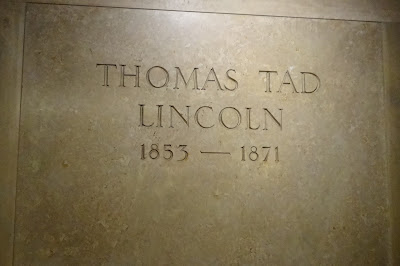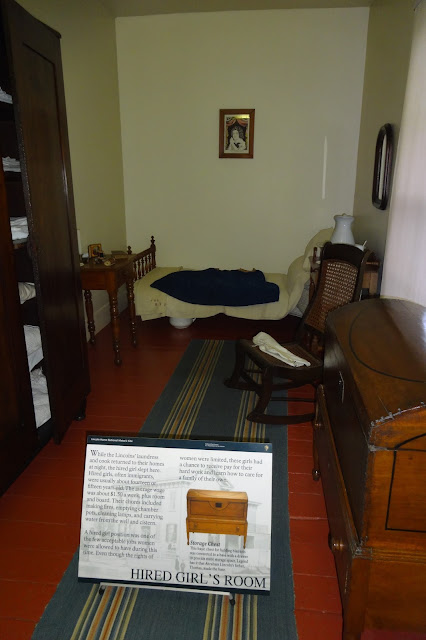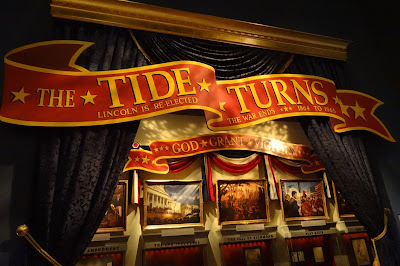
Knowing we needed to get to the Lincoln Home National Historic Site early in order to obtain a ticket for a Park Ranger tour through the Lincoln home, we got up and ate a quick breakfast at the hotel. Tour tickets are on a first come, first serve basis. The weather was cold and rainy so we had to allow a little extra time. Besides, we needed to drop our laundry off at a local laundromat.
When we arrived at the Visitor Center, the Park Ranger at the desk informed us we could catch the tour that had just left. She advised us where we were to meet up with them. Fortunately, the Park Ranger who was going to lead the tour was running a little late so we were able to walk to the meeting location and join the group.
The Park Ranger explained the history of the Lincoln house to us as we met in a small house across the street, out of the bad weather. The Lincolns bought the house in 1844 for $1,200 from the minister who had married them 2 years previously. The family lived in this house for 17 years until Lincoln became President. As their family expanded, they added the second story to accommodate their growing needs. After the brief introduction, we all walked to the front of the house and went inside.
The front and back parlors were the first place we stopped. These two rooms were the largest rooms in the house and were most often the first and sometimes the only stop for a visitor to the Lincoln home. They were decorated to impress and showcase the family's social status. Abraham Lincoln would entertain guests or potential clients, and sometimes, the rooms were used just to conduct household business. In the back parlor, delegates from the Republican National Convention visited on May 19, 1860 to formally offer Abraham Lincoln the Republican nomination for President. It took Lincoln 4 days to accept. He took his first step toward the White House from this room. The back parlor also served as Lincoln's office or study. All of the dark horse hair upholstery furniture in these rooms actually belonged to the Lincoln family.


Although we had entered through the front door, the front entry was blocked off until we got through the sitting room. We loved seeing the Lincoln stovepipe hat hanging on coat and umbrella stand. Also, the doorbell was quite unique, but definitely workable.






Mary Lincoln's room was the only place she could have privacy with a house full of boys. It wasn't always that way. The two youngest boys, Willie and Tad, slept on a trundle bed in Mary's room until they took Robert's room when he went off to college. Her chamber pot was concealed. The chest of drawers came from her family's home in Kentucky.




From there, we went down the back stairs and into the kitchen. Over the years, the Lincoln's made upgrades to kitchen, including the cast iron, wood burning cook stove. This was another sign of luxury. Mr. Lincoln's one room cabin was about the size of the kitchen.

The Park Ranger then took us outside in the backyard. The Lincoln family had a three pot outhouse which again showed their elite status at the time.




The unfinished mural on the side of the building across the tracks from the Lincoln Depot displayed a sign from the building's owners that read, "Much as the life of Abraham Lincoln ended abruptly, so did this mural. We respectfully dedicate this unfinished work to Springfield's best known citizen, and America's greatest President."
There were some interesting pieces of history on display inside, including photos of Lincoln during his years in Springfield.



Across the street was the Old State Capital. The lawn was adorned with American flags, flapping in the wind. In fact, the wind was so strong that people's umbrellas were blowing inside out.



In front of the obelisk, was a giant statue of Lincoln's head. It was said if you rubbed his nose, you would have good luck. Well, I guess you would have to reach it first!
We went inside and entered an awesome rotunda full of symbolism. A sitting Abraham Lincoln bronze statue filled the center of the room. The walls gave the appearance of 16 marble columns, separated by bronze panels on each size. The 16 columns represented Lincoln and the 15 Presidents who came before him. The 36 bronze panels represented one for each State at the time of Lincoln's death.

Next, we left the rotunda and walked through the curved marble corridors that lead to the burial room. Located throughout the corridors were 8 bronze statues created by famous sculptors, depicting significant events in Lincoln's life.

Then, we arrived at the burial room. There was an important sign that explained the details of the room. Abraham Lincoln's tomb itself was massive and made of beautiful marble. Their are flags behind the tomb with significant meaning. The crypt was buried below the visible tomb. On the wall opposite Lincoln's tomb were the burial spots and markers of four of his family members excluding Robert Todd Lincoln. His marker was there, but he is buried at Arlington National Cemetery.


We left the incredible memorial and walked outside to the temporary vault where Lincoln's remains were placed after it arrived off the funeral train and burial services were held. The coffin made several moves until its final resting spot once the memorial structure was completed.

We headed back to our car and drove through the cemetery. There were many memorable and unique gravestones, especially one with Little on it. The rolling hills and beautiful fall colors were beautiful.


Feeling hungry from our busy day, we headed to a Scenic Route 66 restaurant attraction for a late lunch. On the way, we passed the current Illinois State Capitol Building and beautiful fall foliage.





After lunch, we decided to go to the Abraham Lincoln Presidential Museum and Library (http://lincolnlibraryandmuseum.com/index.htm or https://www.illinois.gov/alplm/Pages/default.aspx), hoping to have enough time to complete it without going back the next day. Wow, we were really glad we did! It was the most awesome and unique Presidential museum and library we had seen yet! Not only is it the largest, but it is also the first "experience museum" of its kind. It is definitely worth a trip there...on purpose! From the outside, there were 2 buildings - one was the museum and one was the library.

As we walked into the museum entrance, there was a huge gift shop to one side, which we left for the end. We walked ahead down the wide hallway until we reached the magnificent rotunda or plaza. Every "experience" offered in the museum started from there. However, it was quite overwhelming to take in everything around the rotunda. The ceiling was so high that we felt extremely small. So we just stopped to get our bearings. There in front of our eyes was the Lincoln family, standing in the middle of the rotunda with the White House South Portico, large as life, as their backdrop. The sight was breathtaking, as we stood in silence, taking in every detail.
Our silence was broken when a volunteer directed us into the Union Theater where "Lincoln's Eyes" was getting ready to begin. We found seats and surveyed the stage in front of us with large screens on both sides. Quickly, we realized this was not a normal theater show. There were multiple projectors and special effects, even in the seating areas. The presentation was fully-automated and moved flawlessly, constantly making us feel part of the action. The story of the events and important issues, especially slavery, of Lincoln's presidency were told by an artist on stage. He had been asked to create a painting that captured Lincoln's emotions and feelings, to be displayed at the entrance of the theater. The use of holograms were used on various screens throughout the show. We left the theater in awe of the technology we had just experienced as this story came to life. Was the artist real or a special effect...we were pretty sure he was a hologram, but there was a doubt.
Back in the rotunda, we headed down the path in the woods of various authentic trees reaching upward to the sky. This began our journey through Abraham Lincoln's Pre-Presidential Years.
We began in the recreated boyhood log cabin where we saw young Abe reading by the fireside with his family. Gazing at the realistic details, it was easy to transport back in time.
The area we moved into next depicted the slavery auction with lights and sounds to add the special effects. Again, the details were very real.

We continued on to an early adult Abraham Lincoln in New Salem, where he was shown with Ann Rutledge. Rumors told he was very sweet on Miss Rutledge.

The next gallery shared a glimpse of Lincoln's life in Springfield. Not only did it begin with his courtship of Mary and his home life, but continued on through his legal and political career through the Lincoln-Douglas debates. There were display cases and timelines throughout that shared important items and events. Our favorite part of this gallery was the scene depicting Lincoln sleeping on the couch while his two boys tore up his office while playing. He didn't set too many boundaries for his kids, but some would have been nice.
The highlight was then shifted to his 1860 presidential campaign. As a tribute to NBC news broadcaster, Tim Russert, this section was told as if it was modern times. The televisions control room updated the campaign slogans of all four candidates on tv monitors while including commentary. This was quite a unique experience.


We then proceeded to to the next major experience called The White House Years, which took us into the South Portico. There were seven different areas included in this area.
Once inside, we entered a display about the dresses of the time. Mary Lincoln being fitted for a gown was the highlight as well as other dresses of women dressed for a ball.
"The Whispering Gallery" was a long, dark hallway filled with political cartoons and news articles. Lincoln was very unpopular entering into his presidency (and throughout) so he and his family were the brunt of many mean things. While walking through this hallway, we could hear people laughing and whispering.
The next section was heartbreaking. Scenes showed the Lincolns being pulled away from a White House party as they find out Willie's health has rapidly declined. Mary was totally devastated and could be found, rocking in his room alone.
"The Emancipation Proclamation" area really captured the emotions and tension of the country in video and audio displays. There were areas depicting the Civil War from uniforms, battles, and other significant events. At the end of the walkway, President Lincoln was shown weighing his decision to sign the document.

Then, we walked into the recreation of Lincoln's box at the Ford's Theater. This scene has been seen throughout history. However, here, the tenderness between President and Mary were shown, including the last words he said to her.
From the news spreading around the nation to the funeral train route to the President lying in state, the final display area was the most solemn. At the end of the galleries, we entered into a full scaled replica of the Representatives Hall in the Old State Capitol building in Springfield. The main feature was the over sized display, fully decorated as it would have been as it lay in state. We walked past the closed casket in order to exit the room. The pathway gave us the feeling that we had payed our respects to a beloved President.
We walked out into the rotunda once again and tried to gather our thoughts. The last showing at Ghosts of the Library was about to begin. We went and found a place on the benches, looking at a library in front of us behind glass. Soon, the lights went dark and the show started. It was a combination of drama, information, and special effects to create a "realistic" story. The host told how research is obtained in a historical library from a personal point of view. Things happened that left us very unsure - again, was the host real or a hologram? If a hologram, how did he do the things he did?
As we left the theater in awe, we stood out in the rotunda, asking each other about what we had seen. The show was unlike anything we had ever seen. It was magical. It was entertaining. It was educational. "Wow," was the word both of us kept saying! Pictures could not capture the extraordinary things we saw and heard.
Closing time was getting near. We asked a volunteer to take our picture with the Lincoln family in front of The White House. He gladly agreed.
Once the photos were taken, the volunteer said he saw our awe. He asked if we had a few minutes to go visit The South Portico of The White House. As we walked, Robin asked if the host in the last presentation was real or a hologram. Like a good teacher, he asked us what we thought. We shared our observations and responses. Just then a man walked past us. As the man got further away, the volunteer confessed that he was one of a handful of volunteers that donate their time to act out the story. When we questioned a few things, he explained that the dialogue is recorded. That explained why we couldn't hear the microphone when he put on a uniform.
The volunteer took us to the wax figures on the front porch of the South Portico. First of all, we looked at the emotions between Generals McClellan and Grant. It was obvious they didn't trust each other by the expressions on their faces. Next, he wanted us to see Sojourner Truth and Frederick Douglass on the other side of the porch. He pointed out the details of Sojourner's hands, down to the realistic veins popping through her skin. It was hard to believe these figures weren't alive. With all of the magical special effects happening throughout the Presidential Museum, we were waiting for these figures to come to life!

We thanked our new friend and quickly went to the Museum gift shop which was closing in 20 minutes. After buying a few items to remember this experience, we headed to our car to go pick up our laundry.

Back at the hotel, we collapsed from our busy day. Once we rested, we went to dinner and then to CVS to pick up some medicines. Then it was back to the hotel to call it a day. All in all, we had had a remarkable, but exhausting day! One we will never forget!




































































































